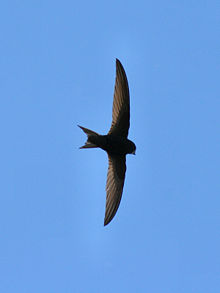Swift
2008/9 Schools Wikipedia Selection. Related subjects: Birds
| Swifts | ||||||||||
|---|---|---|---|---|---|---|---|---|---|---|
 Common Swift, Apus apus
Note wing shape different from swallows |
||||||||||
| Scientific classification | ||||||||||
|
||||||||||
| Genera | ||||||||||
|
Nearly 20, see text. |
The swifts are birds superficially similar to swallows but are actually not closely related to those passerine species at all; swifts are in the separate order Apodiformes, which they formerly shared with the hummingbirds. The treeswifts are closely related to the true swifts, but form a separate family, the Hemiprocnidae.
The resemblances between swifts and swallows are due to convergent evolution reflecting similar life styles based on catching insects in flight.
The family scientific name comes from the Ancient Greek απους, apous, meaning "without feet", since swifts have very short legs and never settle voluntarily on the ground, perching instead on vertical surfaces. The tradition of depicting swifts without feet continued into the Middle Ages, as seen in the heraldic martlet.
Swifts are the most aerial of birds and some, like the Common Swift, even sleep and mate on the wing. Larger species, such as White-throated Needletail, are amongst the fastest flyers in the animal kingdom. One group, the Swiftlets or Cave Swiftlets have developed a form of echolocation for navigating through dark cave systems where they roost. One species, Aerodramus papuensis has recently been discovered to use this navigation at night outside its cave roost also.
Swifts have a worldwide distribution in tropical and temperate areas, but like swallows and martins, the swifts of temperate regions are strongly migratory and winter in the tropics.
Many swifts have a characteristic shape, with a short forked tail and very long swept-back wings that resemble a crescent or a boomerang. The flight of some species is characterised by a distinctive "flicking" action quite different from swallows. Swifts range in size from the Pygmy Swiftlet (Collocalia troglodytes), which weighs 5.4 g and measures 9 cm (3.7 inches) long, to the Purple Needletail (Hirundapus celebensis), which weighs 184 g (6.5 oz) and measures 25 cm (10 inches) long.
The nest of many species is glued to a vertical surface with saliva, and the genus Aerodramus use only that substance, which is the basis for bird's nest soup.
Systematics and evolution
Swifts and treeswifts have long been considered to be relatives of the hummingbirds, a judgement corroborated by the discovery of the Jungornithidae, which were apparently swift-like hummingbird relatives, and of primitive hummingbirds such as Eurotrochilus. Traditional taxonomies place the hummingbird family (Trochilidae) in the same order as the swifts; the Sibley-Ahlquist taxonomy places them in a new order, Trochiliformes, which forms a superorder with the swifts and treeswifts (and no other birds).
The taxonomy of the swifts is in general complicated, with genus and species boundaries widely disputed, especially amongst the swiftlets. Analysis of behaviour and vocalizations is marred by common parallel evolution, while analyses of different morphological traits and of various DNA sequences have yielded equivocal and partly contradictory results (Thomassen et al., 2005).
The Apodiformes diversified during the Eocene, at the end of which the extant families were present; fossil genera are known from all over temperate Europe, between today's Denmark and France, such as the primitive Scaniacypselus (Early - Middle Eocene) and the more modern Procypseloides (Late Eocene/Early Oligocene - Early Miocene). A prehistoric genus sometimes assigned to the swifts, Primapus (Early Eocene of England), might also be a more distant ancestor.
Taxonomic list of Apodidae
Tribe Cypseloidini
- Genus Cypseloides - includes Streptoprocne
- Chestnut-collared Swift, Cypseloides rutilus
- Tepui Swift, Cypseloides phelpsi
- Black Swift, Cypseloides Niger
- White-chested Swift, Cypseloides lemosi
- Rothschild's Swift, Cypseloides rothschildi
- Sooty Swift, Cypseloides fumigatus
- Spot-fronted Swift, Cypseloides cherriei
- White-chinned Swift, Cypseloides cryptus
- White-fronted Swift, Cypseloides storeri
- Great Dusky Swift, Cypseloides senex
- Genus Streptoprocne
- White-collared Swift, Streptoprocne zonaris
- Biscutate Swift, Streptoprocne biscutata
- White-naped Swift, Streptoprocne semicollaris
Tribe Collocalini - swiftlets
- Genus Collocalia (3-4 species)
- Genus Aerodramus (about 25 species, sometimes included in Collocalia)
- Genus Hydrochous - Waterfall Swift
- Genus Schoutedenapus - African swiftlets (2 species)
Tribe Chaeturini - needletails
- Genus Mearnsia
- Philippine Needletail, Mearnsia picina
- Papuan Spinetail, Mearnsia novaeguineae
- Genus Zoonavena
- Malagasy Spinetail, Zoonavena grandidieri
- Sao Tome Spinetail, Zoonavena thomensis
- White-rumped Needletail, Zoonavena sylvatica
- Genus Telacanthura
- Mottled Spinetail, Telacanthura ussheri
- Black Spinetail, Telacanthura melanopygia
- Genus Rhaphidura
- Silver-rumped Needletail, Rhaphidura leucopygialis
- Sabine's Spinetail, Rhaphidura sabini
- Genus Neafrapus
- Cassin's Spinetail, Neafrapus cassini
- Bat-like Spinetail, Neafrapus boehmi
- Genus Hirundapus
- White-throated Needletail, Hirundapus caudacutus
- Silver-backed Needletail, Hirundapus cochinchinensis
- Brown-backed Needletail, Hirundapus giganteus
- Purple Needletail, Hirundapus celebensis
- Genus Chaetura (9 species)
Tribe Apodini - typical swifts
- Genus Aeronautes
- White-throated Swift, Aeronautes saxatalis
- White-tipped Swift, Aeronautes montivagus
- Andean Swift, Aeronautes andecolus
- Genus Tachornis
- Tachornis uranoceles (fossil; Late Pleistocene of Puerto Rico)
- Antillean Palm Swift, Tachornis phoenicobia
- Pygmy Swift, Tachornis furcata
- Fork-tailed Palm Swift, Tachornis squamata
- Genus Panyptila
- Lesser Swallow-tailed Swift, Panyptila cayennensis
- Great Swallow-tailed Swift, Panyptila sanctihieronymi
- Genus Cypsiurus
- Asian Palm Swift, Cypsiurus balasiensis
- African Palm Swift, Cypsiurus parvus
- Genus Apus (some 17 species)